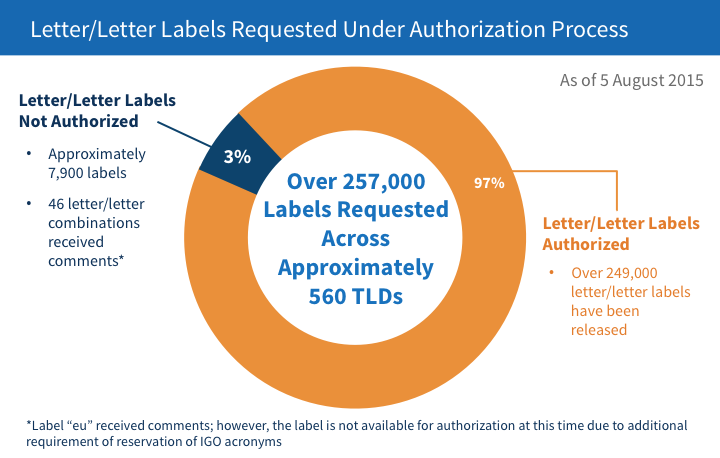We recently passed the half-year mark since ICANN launched its Authorization Process for the Release of Two-Character ASCII Labels. The process, which was originally published in December 2014, explains that requested, non-objected to letter/letter two-character ASCII labels will be released after a 60-day comment period. Since that time, over 249,000 letter/letter two-character domains have been authorized across approximately 560 new generic top-level domains, and the numbers are growing weekly. Approximately 7,900 (3 percent) of the labels requested for release have received comments and are being withheld until these comments have been addressed. I'm pleased to announce that we now have a draft process to fully consider comments received and evaluate the labels that have been withheld thus far.
Background on Resolving Contested Two-Character Domains
Specification 5 of the Registry Agreement, which was published in 2013, provides for two methods to release two-character ASCII domain names:
- Two-character names may be released if the registry operator reaches agreement with the related government and country-code manager of the string, or;
- The registry operator may propose the release of the names based on its implementation of measures to avoid confusion with the corresponding country codes, subject to approval by ICANN.
ICANN's primary involvement in the release of two-character labels falls under the second method, as it requires our approval. In October 2014, the ICANN board passed a resolution directing staff to "develop and implement an efficient procedure for the release of two-character domains." In February 2015, the ICANN board further directed staff to "implement improvements to the process to alert relevant governments when requests are initiated," and stated, "Comments from relevant governments will be fully considered." The Authorization Process for the Release of Two-Character ASCII Labels is the result of the board's direction.
As mentioned in the introduction, about three percent of labels requested for release through the authorization process have not yet been authorized for release due to concerns expressed by governments. In the interest of transparency, we are publishing the draft process for considering these comments.
Comments Consideration Process
In the coming months, ICANN intends to undertake a series of steps to evaluate requested labels that have received comments from governments. This process will address all previous requests and comments, and we expect it to result in the development of criteria by which ICANN can evaluate future requests and comments.
As mentioned previously, method two for releasing two-character labels according to the Registry Agreement suggests that a registry operator may request the release of two-character labels provided that it has adequate measures in place to mitigate potential confusion with corresponding country codes. As such, we believe this to be the appropriate measure for evaluating requests.
Below is the step-by-step outline of the process.
1. ICANN reaches out to all relevant governments to further clarify their comments.
Within the next few months, ICANN will reach out to all governments that have submitted comments to better understand their concerns, including why a government may believe a specific label.TLD combination causes confusion with the corresponding country code. As ICANN evaluates the responses to our outreach, comments not pertaining to confusion might be directed to recourse mechanisms outside of the Authorization Process, such as the Abuse Point of Contact, which is used when abuse is suspected.
The reasons behind comments that have been submitted to date are varied: about 33 percent mention confusion with the corresponding country code as a reason to not release a specific two-character label; approximately 11 percent identified GAC Category 1 strings1 as point of concern; and about half of the submitted comments did not include an explanation.
2. ICANN reaches out to registries to respond with a mitigation plan.
Furthermore, ICANN will ask registries to respond to governments' comments with measures to be implemented to avoid confusion with corresponding country codes. As with the governments' comments clarification, the registries' mitigation plans will be published.
3. ICANN aggregates governments' comments and registries' mitigation plans to draft the criteria for approval.
Once ICANN has received feedback within an allotted timeframe from both governments and registries, ICANN will aggregate the comments that governments have raised, as well as the mitigation measures that registries have identified. From those inputs, ICANN will endeavor to find commonality to draft the criteria by which ICANN can evaluate whether the measures identified by a registry successfully mitigate the confusion raised by the government. These draft criteria will be posted for public comment before final adoption.
4. ICANN takes into consideration the feedback provided by community and creates finalized criteria for approval.
Taking into consideration the feedback provided by the community during the Public Comment period, ICANN will strive to produce a finalized set of criteria for approval, which will be used to evaluate mitigation plans provided by the registries for previously commented on labels. Moreover, these finalized criteria for approval may be used to evaluate all future two-character authorization requests that receive comments from relevant governments. Considering the breadth of TLDs involved, it is conceivable that multiple sets of criteria could be adopted to apply to different subsets of TLDs such as those with a Specification 13 provision for a brand TLD.
The current framework of the Authorization Process, whereby a registry submits an authorization request and relevant governments may submit comments, is not expected to change. However, we believe the finalized criteria for approval will help everyone with a more clearly defined standard with which we can evaluate future requests.
We look forward to launching the updates to the process for the release of two-character ASCII labels later this month, and to the community's guidance in creating a concrete set of criteria to evaluate letter/letter labels that receive comments.
If you have comments or questions regarding this process, please do not hesitate to contact me at cyrus.namazi@icann.org.
1 To view the list of GAC Category 1 strings, please see https://www.icann.org/en/system/files/files/resolutions-new-gtld-annex-2-05feb14-en.pdf [PDF, 61 KB]. To view the ICANN New gTLD Program Committee's Resolution regarding GAC 1 category strings, please see https://www.icann.org/resources/board-material/resolutions-new-gtld-2014-02-05-en#1.a



